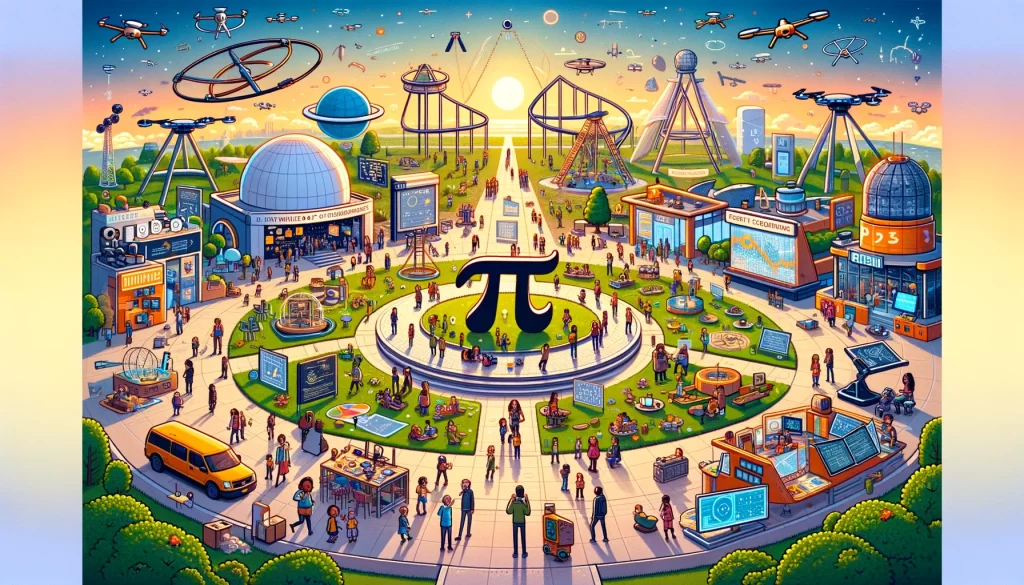Pi is a number that keeps going forever without repeating any pattern in its numbers. Think of it like a never-ending mystery that mathematicians love to explore. But here’s a fun fact: the smart folks at NASA who send rockets into space and explore planets only need to use a tiny part of pi for their complex calculations. They mostly use just the first 15 numbers after the decimal point. Even when they’re dealing with space stuff that blows our minds, they rarely need more than a few dozen digits of pi.
So, what is pi? You may remember from math class; it’s a special number you get when you divide the distance around a circle (the circumference) by the distance across it through the center (the diameter). Basically, pi helps us figure out how big around a circle is if we know how wide it is. Pi is usually written as 3.14, which is why March 14th is celebrated as Pi Day.
Scientists have figured out pi to a whopping 62.8 trillion numbers after the decimal point using a supercomputer that worked non-stop for more than 100 days! But beyond those digits, pi remains a mystery.
However, for most things you’d need pi for in real life, you only need to remember a few numbers after the decimal. NASA scientists, for example, are pretty okay with just 15 digits (3.141592653589793) when they’re studying things in our solar system.

The reason that they don’t need any more is that the difference those extra digits would make is so tiny, it doesn’t really affect their calculations, even when they’re working on stuff as big as planets or stars, according to NASA’s Jet Propulsion Laboratory.
Let’s talk Earth. Our planet is about 7,900 miles wide, which means it’s about 24,900 miles around. If you used the first 16 digits of pi or a version of pi with hundreds of digits to calculate Earth’s circumference, the difference would be way smaller than the width of a human hair!
Even when they calculate huge distances, like the Voyager 1 probe’s journey into interstellar space, which is over 15 billion miles from Earth, the difference in using more digits of pi is still really small – less than the width of your little finger.
But, there are some super-duper precise calculations where more digits of pi are needed. For example, if you wanted to figure out the size of a circle that could wrap around the entire known universe, you’d need pi to 38 decimal places to be as accurate as we can currently measure the width of an atom. That’s because the universe is so huge – about 46 billion light-years across, considering the distance light has traveled since the universe began expanding right after the Big Bang.
This article is based on the following article:

Background Information
By understanding these concepts, readers will better appreciate the role of pi in science and technology and why even at the forefront of space exploration, only a slice of pi is necessary. This context not only enriches their understanding of the article but also highlights the interconnectedness of mathematical concepts with real-world applications and challenges.
1. What is Pi (π)?
Pi, represented by the Greek letter “π,” is a mathematical constant. It’s the ratio of a circle’s circumference (the distance around the circle) to its diameter (the distance across the circle through its center). No matter how big or small the circle is, this ratio will always equal pi. Pi is an irrational number, meaning it cannot be expressed exactly as a simple fraction and its decimal representation goes on forever without repeating.
2. The Significance of Pi in Mathematics and Science
Pi is crucial in mathematics, science, and engineering because circles are everywhere, from the wheels on your bike to the planets orbiting the sun. Pi is used to calculate the circumference and area of circles, and it appears in formulas for waves, sound, light, and much more. Understanding pi is essential for fields ranging from construction and engineering to physics and astronomy.
3. NASA and Space Exploration
NASA, the National Aeronautics and Space Administration, is responsible for the United States’ civilian space program and for aeronautics and aerospace research. NASA uses pi in various ways, from calculating the trajectories of spacecraft to determining the areas of surfaces on other planets.
4. Why Only a Few Digits of Pi Are Needed
The article mentions that NASA only needs about 15 digits of pi for most calculations. This is because the additional digits do not significantly change the results in real-world applications. The level of precision required for space missions is incredibly high, but even so, the difference made by the digits beyond the 15th decimal is often smaller than we can measure or that would have a practical impact on the mission’s success.
5. Real-World Applications of Pi
Aside from space exploration, pi is used in various real-world applications. For example, engineers use pi when designing roads, bridges, and buildings. Pi is also used in computing, to model the spread of diseases, in finance, and even in art and music.
6. Celebrating Pi: Pi Day
Pi Day is celebrated on March 14th (3/14) around the world. It’s a fun way to acknowledge the importance of pi, with activities often involving eating pie, discussing the significance of pi, and participating in pi-related competitions.
7. The Challenge of Calculating Pi
The quest to calculate more digits of pi has been ongoing for centuries, with computers now able to compute trillions of digits. While these achievements are impressive, they are more about testing the limits of human knowledge and computational power than about the practical need for such precision.
Please subscribe to Insight Fortnight, our biweekly newsletter!
